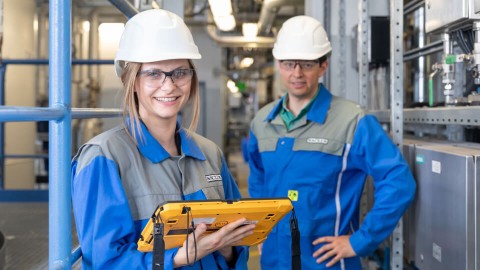VINNAPAS® 543 ED

VINNAPAS® 543 ED is a versatile polymer dispersion based on vinyl acetate and ethylene with excellent compatibility towards cement, pigments and fillers.
Eigenschaften
- VINNAPAS® 543 ED is a dispersion based on vinyl acetate and ethylene.
- VINNAPAS® 543 ED is produced without adding APEO, plasticizers or organic solvents.
Datenblätter
VINNAPAS® 543 ED offers several advantages in a wide range of building chemical and construction applications. It exhibits a high compatibility towards cement and its influence on cement setting is marginal. The product shows an excellent compatibility with inorganic fillers like as CaCO3 and imparts high bond strengths. VINNAPAS® 543 ED is compatible with other dispersions (such as styrene/acrylic and pure acrylic dispersions) and especially suitable for use in applications such as waterproofing membranes (WPM), tile adhesives, external thermal insulation composite systems (ETICS/EIFS), primer and bonding agents as well as cement admixtures.
For typical application fields of VINNAPAS® 543 ED you can refer to the section "application". Please discuss additional applications with your WACKER customer representative.
Processing
VINNAPAS® 543 ED can be blended with most anionic and/or nonionic aqueous polymer dispersions. However, the compatibility of the mixture should be tested by means of storage tests.
VINNAPAS® 543 ED has a minimum film forming temperature of 0°C. Therefore, there is no need to add any film-forming or coalescing agents to the formulation.
VINNAPAS® 543 ED is compatible with common pigments and extenders and is easy to process.
Wird das Produkt in anderen Anwendungen als den aufgeführten Anwendungen eingesetzt, liegen Auswahl, Verarbeitung und Verwendung des Produktes in der alleinigen Verantwortung des Abnehmers. Dabei sind alle gesetzlichen und sonstigen Regelungen zu berücksichtigen.
Bei Fragen in Bezug auf die Zulassung für den Kontakt mit Lebensmitteln nach Paragraph 21 CFR (US FDA) bzw. dem deutschen Lebensmittelrecht (BfR) wenden Sie sich bitte an:
Wacker Chemie AG, Gisela-Stein-Strasse 1, 81671 München, Deutschland
Lagerung
When the dispersion is stored in tanks, proper storage conditions must be maintained. VINNAPAS® 543 ED has shelf life of 9 months if stored in the original, unopened containers at temperatures between 5 and 30 °C. Any longer periods for the maximum storage period that may be described in the Certificate of Analysis which accompanies each shipment of VINNAPAS® 543 ED, take preference over this suggestion in which case the time period stated in the Certificate of Analysis shall be solely authoritative. Please refer to "Best use before date" on the packaging label. Storage beyond the date specified does not mean that the product can't be used anymore, but the user should perform a quality check on the properties necessary for the intended application. Iron or galvanized-iron equipment and containers are not recommended because the dispersion is slightly acidic. Corrosion may result in discoloration of the dispersion or its blends when further processed. Therefore the use of containers and equipment made of ceramics, rubberized or enameled materials, appropriately finished stainless steel, or plastic (e.g. rigid PVC, polyethylene or polyester resins) is recommended. As polymer dispersion may tend to superficial film formation, skins or lumps may form during storage or transportation. Filtration is therefore recommended to utilization prior of the product.
Preservation for Transport, Storage and further Processing
VINNAPAS® 543 ED is adequately preserved during transportation and storage if kept in the original, unopened containers. However, if it is transferred to storage tanks, the dispersion should be protected against microbial attack by adding a suitable preservative package.
Measures should also be taken to ensure cleanliness of the tanks and pipes. In unstirred tanks, a layer of preservative-containing water should be sprayed onto the surface of the dispersion to prevent the formation of unwanted skin and possible attack by microorganisms. The thickness of this water layer should be < 5 mm for low viscosity dispersions and up to 10-20 mm for high viscosity products. Proper procedures - periodic tank cleaning and sanitization - must be set up in order to prevent microbial attack. Contact your biocide representative/supplier for further plant hygiene recommendations. Measures should be taken to ensure that only clean air enters the tank when the dispersion is removed.
Finished products manufactured from polymer dispersions usually also require preservation. The type and scope of preservation will depend on the raw materials used and anticipated sources of contamination. The compatibility with other components and the efficacy of the preservative should always be tested in the respective formulation. Preservative manufacturers will be able to advise you about the type and dosage of preservative required.
Vertrieb & Support
Wie können wir Ihnen helfen?
- Benötigen Sie Unterstützung bei der Produktauswahl oder wünschen Sie eine technische Beratung? Kontaktieren Sie unsere Experten.


